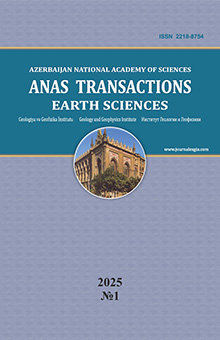№ 2,
2020
Download the article
Single-station polarization analysis according to the Zagatala earthquake on May 7, 2012
Republican Seismological Survey Center of National Academy of Sciences of Azerbaijan 123, H.Javid pr., Baku, Az 1143: sabina.k@mail.ru
Summary
A-
A+
The article presents an analysis of the parameters of split shear waves from a surface (h = 8 km) earthquake that occurred within the Great Caucasus in Zagatala region on May 7, 2012 with ml = 5.6. Spatial analysis of waveforms is carried out using 3-component digital signal recordings. For selected sections of the 3-component recording in the DIMAS program, a three-dimensional graph of the particle motion path and the projection of the motion path on the NE, NZ, EZ planes is constructed. The birefringence effect, i.e. the shear wave is split into two (S1 and S2), each of which has its own polarization and speed for broadband three-component records (НHE, НHN, НHZ) of one seismic station ZKT. This made it possible to study small-scale strains for a better understanding of the dynamic processes and properties chances of the medium with depth. At the same time, the dependence of the parameters of split S waves on the direction of propagation and spatial heterogeneity of the physical properties of the medium requires a more detailed analysis of the data in space and time.It was established that the fast and slow S-waves are well distinguished in the wave field, their polarization vectors are mutually orthogonal. Subsequent waves have much smaller amplitudes, and their azimuths are close to the azimuth of the slow wave S2. The delay time between the first and second phases of the shear wave for the ZKT station is 3 seconds with the orientation of the polarization vectors along the azimuths 140º and 70º.
Keywords: polarization of shear SH and SV waves, Lissajous figures, incident angle and azimuth of the seismic waves
REFERENCES
Galperin Y.I. Polarization method of seismic research. Nedra. Moscow, 1977, 279 p. (in Russian).
Gorshkalev S.B., Karsten V.V., Afonina E.V., Bekeshko P.S., Korsunov I.V. The results of the study of azimuthal anisotropy of the geological section in Pelyatkinskaya Square according to multi-wave VSP and 3D seismicdata. Seismic Exploration Technologies, No. 3, 2011, pp. 60-70 (in Russian).
Droznin D.V., Droznina S.Y. Interactive seismic signal processing program Dimas. Kamchatka branch of the Geophysical Service of the Russian Academy of Sciences, Petropavlovsk-Kamchatsky, 2004, pp. 1-5 (in Russian).
Droznin D.V., Droznina S.Y. Interactive program for seismic signal processing DIMAS. Seismic Instruments, Vol. 46, No. 3, 2010, pp. 22-34(in Russian).
Luneva M.N. Temporal variations in the parameters of split S-waves from weak local earthquakes of close localization near eastern Hokkaido.Institute of Tectonics and Geophysics, Far Eastern Branch of the Russian Academy of Sciences. Physics of the Earth, No. 11, 2008, pp. 47-63.
Luneva. M.N. Seismic anisotropy and frequency dependence of wave parameters from weak earthquakes in Kuril subduction zone. Physical Mechanics, No. 12, 2009, pp. 55-62 (in Russian).
Kazimova S.E., Kazimov I.E. Seismotomographic studies of the Earth’s crust of the southern slope of the Greater Caucasus. Catalog of RSSC of ANAS, 2010, pp. 82-88 (in Russian).
Kazimova S.E., Kazimov I.E. Seismic anisotropy of shear wave parameters on the example of the Hajigabul earthquake on February 10, 2014 with ml = 5.8.Geology and Geophysics of the South of Russia, No. 3, 2016, pp. 141-151 (in Russian).
Kazimov I.E., Kazimova S.E. Seismic anisotropy of rocks of the Mesocenozoic complex of the Greater Caucasus (within Azerbaijan). Proceedings ANAS, the sciences of Earth, 2011, pp. 29-34 (in Russian).
Yetirmishli G.J., Kazimov I.E. Separation of transverse wave arrivals by polarization analysis.Catalog of RSSC of AN-AS, 2007, pp. 174-181 (in Russian).
https://en.wikipedia.org/wiki/Polarization_(waves)
DOI:
10.33677/ggianas20200200045
